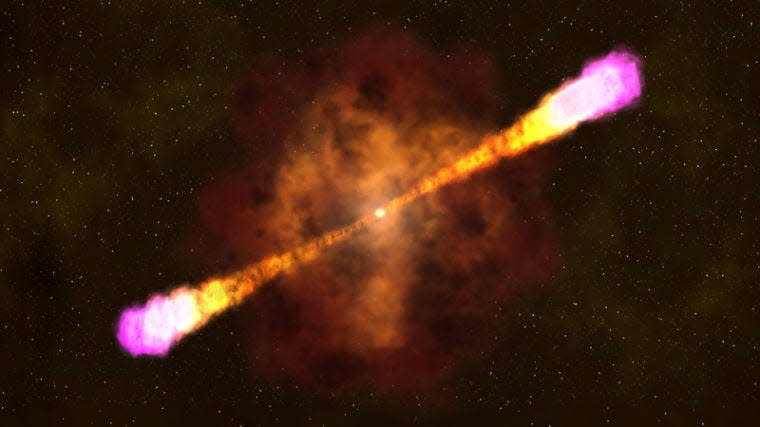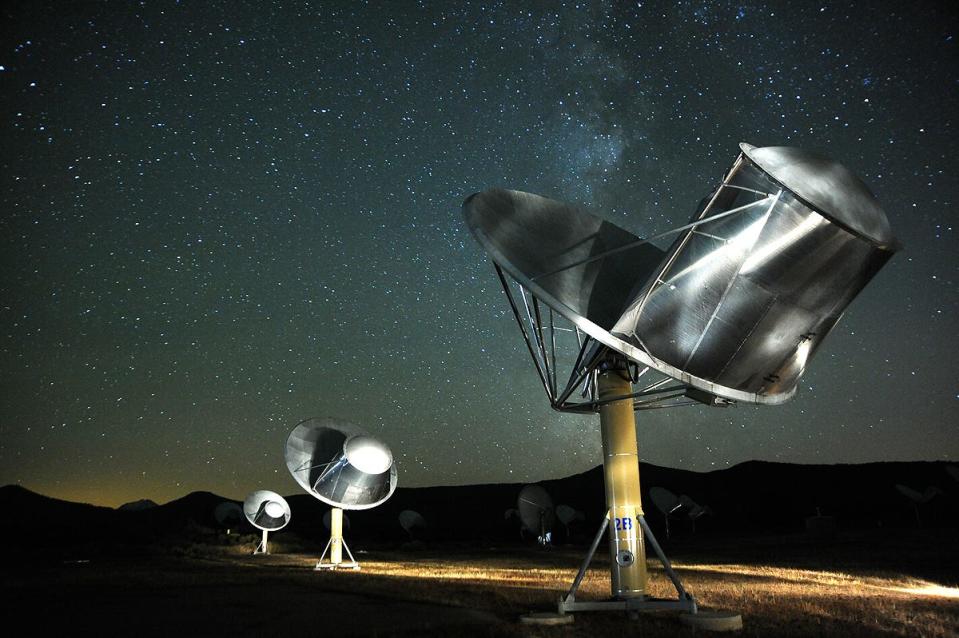Astronomers at Hat Creek Observatory in Shasta County track 'brightest object ever seen'

Astronomers at Hat Creek Radio Observatory in northeast Shasta County are partnering with NASA and other space agencies to track what scientists say is the brightest gamma-ray burst ever recorded.
SETI's Allen Telescope Array at Hat Creek “was the second radio telescope to detect the afterglow of the BOAT,” an acronym for Brightest Object of All Time, Project Scientist Wael Farah said.
The BOAT is likely a once in 10,000-year phenomenon, according to NASA.
Gamma rays are high-energy radiation that pass through Earth all the time. But the BOAT was the whopper of all gamma bursts.
This burst was pointed straight at Earth, giving astronomers a superb view. It "triggered detectors on numerous spacecraft, and observatories around the globe followed up,” NASA reported. "The burst was so bright it effectively blinded most gamma-ray instruments in space, which means they could not directly record the real intensity of the emission."

Earthlings don’t need to worry about a gamma ray overdose from the burst.
“The BOAT emanated from two billion light-years away,” Farah said. One light-year is the distance light travels in one year, making the BOAT's origin point "a bit more than 10 sextillion miles away,” said Farah.
First detected by the Fermi Gamma-ray Space Telescope on Oct. 9, 2022, scientists think the BOAT was caused by the “violent death of a massive star, in a phenomenon called a core-collapse supernova,” Farah said.
When giant stars much bigger than our solar system's sun burn out, their nuclear energy ― the reaction that produces their light ― they collapse and explode, “shattering the material that was once part of the star” into the area between solar systems, said Farah. “What’s left behind is either a very dense object called a neutron star or a black hole,” Farah said.
Sometimes a black hole belches a huge streaming gamma burst from two opposite ends, according to NASA.
Astronomers know time is of the essence when anything happens so far away. They have instruments that detect phenomena like the BOAT that alert observatories to point their telescopes in a single direction. “Within an hour, x-ray, ultraviolet and optical telescopes slewed to the position of the source" of the BOAT "and started recording data, detecting it and classifying it as a core-collapse supernova,” Farah said.
When the first alert went out, the Allen Telescope Array at Hat Creek ― about 15 miles north of Old Station and 75 miles east of Redding ― was on the wrong side of the planet. Farah and his team had to wait 8.5 hours while Earth rotated, clearing the way for them to point the radio telescope at the BOAT, he said.
What astronomers really saw last Oct. 9 was a single point that suddenly became incredibly bright, then faded away.
“Sounds boring, but there's more to it than just a point,” Farah said.
“The BOAT stands out because it’s the brightest out of all the thousands” of phenomena “we’ve seen with our telescopes so far," he said. "This initial detection was crucial to further our understanding of how a supernova shell expands” and how it interacts with the material in space around it, he said.
Gamma ray burst NASA explains gamma ray bursts
More than eight months after it was first detected, astronomers still have their eyes on the impressive point of light, like watching a candle slowly burn away.
While it’s very far away, instruments on Earth will probably be able to detect the supernova’s afterglow for decades, according to NASA.
Astronomers, including those at the Allen Telescope Array at Hat Creek, are still monitoring the BOAT, watching what's left of the supernova interact with and settle into its environment, Farah said. Eventually "everything tends to calm down until it becomes undetectable with our instruments," he said.
Jessica Skropanic is a features reporter for the Record Searchlight/USA Today Network. She covers science, arts, social issues and news stories. Follow her on Twitter @RS_JSkropanic and on Facebook. Join Jessica in the Get Out! Nor Cal recreation Facebook group. To support and sustain this work, please subscribe today. Thank you.
This article originally appeared on Redding Record Searchlight: Hat Creek Observatory astronomers track 'brightest object ever seen'

